If you’ve ever typed “best acoustic guitar strings” into a search bar, you’re likely looking to elevate your playing experience. Whether you’re tired of your usual strings and crave a change, or you’re a beginner guitarist seeking guidance, you’ve come to the right place. As a guitarist with over two decades of experience playing various acoustic guitars, from travel-sized to classical, let me guide you through selecting the ideal strings for your acoustic steel-string guitar.
Choosing guitar strings is deeply personal. For me, the most crucial factor is string gauge. While different brands might offer subtle variations in feel, the gauge fundamentally impacts your guitar’s playability and sound. Switching brands might bring minor tweaks, but altering the gauge creates a significant difference in your instrument’s overall performance. I delve into string gauge intricacies in the FAQs section below, which I highly recommend exploring to deepen your understanding.
Another vital consideration is whether to choose coated or uncoated strings. These two types differ noticeably in feel and sound. To my ear, coated strings sound slightly less vibrant than uncoated ones. However, for live performances, I always opt for coated strings because of their longevity. For home practice or recording, where sound quality is paramount, I prefer uncoated strings for their brighter tone.
Deciding what’s best for you can be challenging, and many players stick with what they know. However, I genuinely advise experimenting with different strings and gauges across your guitars. It can dramatically alter your guitar’s sound and playability, injecting fresh inspiration if you feel stuck in a musical rut. Below, I’ve curated six of the Best Acoustic Steel Guitar Strings currently available, each excelling in different areas. Let’s dive in.
Best Acoustic Steel Guitar Strings: Product Guide
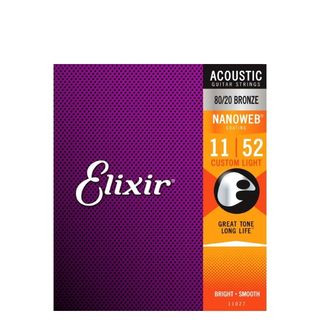 Best acoustic steel guitar strings for overall performance: Elixir Nanoweb 80/20 Bronze
Best acoustic steel guitar strings for overall performance: Elixir Nanoweb 80/20 Bronze
Best Overall
1. Elixir Nanoweb 80/20 Bronze
Material: 80/20 Bronze
Coating: Nanoweb
Pros: + Superb sound quality + Extended lifespan
Cons: – Higher price point
Elixir Nanoweb 80/20 Bronze strings are my go-to choice for all my gigging acoustic guitars. If durability is your priority, these strings are hard to beat. Regularly wiping them down after playing further extends their life.
While coated strings might initially feel different if you’re used to uncoated ones, Elixirs closely mimic the feel of traditional strings compared to other coated options I’ve tried.
The sound is slightly more subdued than some uncoated strings, but unless you’re recording with high-end microphones, the difference is negligible. They can even be beneficial for overly bright-sounding acoustic guitars, lending a more balanced tone.
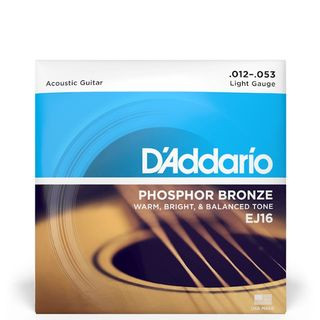 Best acoustic steel guitar strings for beginners: D’Addario EJ16 Acoustic Phosphor Bronze
Best acoustic steel guitar strings for beginners: D’Addario EJ16 Acoustic Phosphor Bronze
Best for Beginners
2. D’Addario EJ16 Acoustic Phosphor Bronze
Material: Phosphor Bronze
Coating: N/A
Pros: + Excellent value for money + Wide range of gauges available
Cons: – Shorter lifespan compared to coated strings
D’Addario EJ16s have been a staple for me for years. In fact, they were the first set of acoustic strings I ever bought. Their combination of affordability and extensive gauge selection makes them ideal for experimenting on different acoustic guitars to optimize playability.
Sonically, they are fantastic, adding a clear and open voice to any acoustic. The main drawback is their shorter lifespan as they are uncoated. However, given their price, frequent string changes aren’t a significant concern if you prioritize fresh tone.
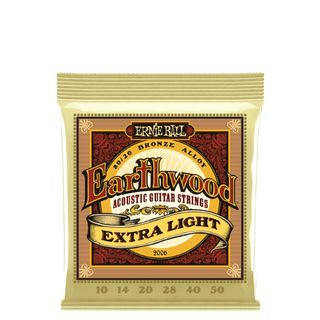 Best budget acoustic guitar strings: Ernie Ball Earthwood 80/20 Bronze
Best budget acoustic guitar strings: Ernie Ball Earthwood 80/20 Bronze
Best Budget Option
3. Ernie Ball Earthwood 80/20 Bronze
Material: 80/20 Bronze
Coating: N/A
Pros: + Very affordable + Well-balanced sound
Cons: – Can produce more finger squeak
I primarily use Ernie Ball Slinky electric guitar strings and they are renowned in the electric guitar world. However, their acoustic strings, the Ernie Ball Earthwood range, are often overlooked.
Ernie Ball Earthwood strings are a fantastic, budget-friendly option that delivers great performance. While not my everyday choice, I highly recommend them to beginners seeking their first set of strings.
The overall sound is impressive for the price, though I find them slightly squeakier with finger noise compared to some other brands. If you want to explore different gauges without breaking the bank, these are perfect.
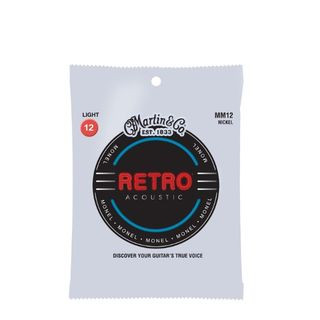 Best acoustic guitar strings for fingerpicking: Martin Retro Monel Acoustic Guitar Strings
Best acoustic guitar strings for fingerpicking: Martin Retro Monel Acoustic Guitar Strings
Best for Fingerpicking
4. Martin Retro Monel Acoustic Guitar Strings
Material: Nickel Copper
Coating: N/A
Pros: + Warm and mellow tone + Good value
Cons: – Not as bright as other options
While no strings are exclusively for fingerpicking, I prefer strings with less treble and “clank” for my fingerstyle acoustic guitars.
Martin Retro strings fit this perfectly, offering a warmer tone right out of the box compared to typical sets. This warmer sound comes from the nickel/copper wrap, differentiating them from others on this list.
I found them surprisingly durable for uncoated strings. While the warmer tone might not appeal to everyone, I believe they are an excellent choice for fingerstyle players.
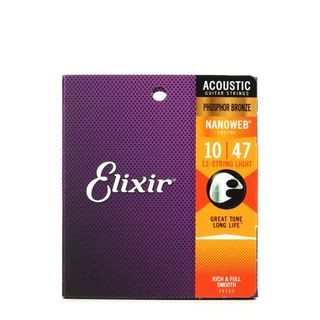 Best acoustic guitar strings for 12-string guitars: Elixir Nanoweb Phosphor Bronze 12-String Acoustic Guitar Strings
Best acoustic guitar strings for 12-string guitars: Elixir Nanoweb Phosphor Bronze 12-String Acoustic Guitar Strings
Best for 12-String Guitars
5. Elixir Nanoweb Phosphor Bronze 12-String
Material: Phosphor Bronze
Coating: Nanoweb
Pros: + Quick settling + Long-lasting tone
Cons: – More expensive
Restringing a guitar isn’t enjoyable for most, but restringing a 12-string is particularly tedious. I own only one 12-string currently, and I dread every string change.
My preference for Elixir strings on my 12-string stems from the extended time between string changes offered by coated strings. They are pricier, but the time saved is worth it for me.
I also love their sound on a 12-string. Excessive overtones can be very prominent on 12-string guitars, but Elixirs, due to their coating, offer a slightly more muted tone and settle in much faster than uncoated sets.
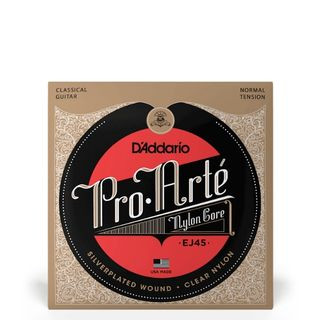 Best nylon guitar strings for classical guitars: D’Addario EJ45 Pro-Arte Normal Tension Classical Guitar Strings
Best nylon guitar strings for classical guitars: D’Addario EJ45 Pro-Arte Normal Tension Classical Guitar Strings
Best Nylon Strings (For Classical Guitars)
6. D’Addario EJ45 Pro-Arte Normal Tension
Material: Nylon, Silver-Plated Copper
Coating: N/A
Pros: + Warm and rich sound + Balanced tension
Cons: – Some players prefer higher tension
If you’re restringing a classical guitar, D’Addario EJ45 Pro-Arte nylon guitar strings are among the best. Two of my classical guitars are currently strung with these, and they perform exceptionally well.
D’Addario utilizes a multi-filament nylon core, which translates to consistent responsiveness and a warm tone. The treble strings are clear yet not overpowering, facilitating a balanced sound for fingerpicking.
I prefer the normal tension set, which provides a good balance between playability and projection. If you need more volume, especially for purely acoustic playing, D’Addario offers a higher tension set as well.
FAQs About Acoustic Steel Guitar Strings
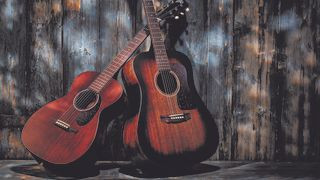 Acoustic guitars in soft focus on dark stage background for frequently asked questions section
Acoustic guitars in soft focus on dark stage background for frequently asked questions section
(Image credit: Future)
What is the best string gauge for acoustic guitars?
String gauge refers to a string’s thickness or diameter. A higher gauge means a thicker string. Gauge significantly impacts your guitar’s playability, tone, and playing style.
Guitar strings are measured in thousandths of an inch and sets are typically named after their thinnest string, the high E. A “set of 12s” has a high E string of 0.012 inches in diameter.
Thicker strings generally produce a fuller sound. They are louder than thinner strings with a rounder, bassier low end and are more durable—a significant advantage. However, thicker gauges can be challenging if you’re still developing hand strength, especially for bending strings and fast playing. If you’re a heavy strummer or prefer lower tunings, thicker strings are beneficial.
Lighter gauge strings are easier to fret and bend, and they sound brighter. The trade-off is losing some low-end depth. Some players find this worthwhile, others don’t.
Consider your guitar’s body size. Smaller-bodied acoustics might be complemented by lighter gauge strings, while dreadnought or jumbo-sized guitars might benefit from thicker strings. There are no strict rules; some use heavier strings on smaller bodies for depth and vice versa. Experiment to find your preference!
Which acoustic strings are best for beginners?
For beginner acoustic guitar players, choosing appropriate strings is vital. You need strings that balance playability and tone. Understanding string gauges and their impact on sound and playing is key.
Here are common generic acoustic guitar string gauges. Brands may vary slightly, and some offer hybrid sets, but this is a good general guide:
Extra light: .010 .014 .023 .030 .039 .047
Custom light: .011 .015 .023 .032 .042 .052
Light: .012 .016 .025 .032 .042 .054
Medium: .013 .017 .026 .035 .045 .056
Heavy: .014 .018 .027 .039 .049 .059
For standard tuning, Extra Light or Custom Light strings are recommended. Often called “sets of 10s” or “11s,” they offer a bright, punchy tone with lower string tension, making them easier to play. As your playing becomes more comfortable, try heavier strings, but super heavy gauges are unnecessary unless your style demands it.
Note that electric guitar gauge names differ. Avoid comparing acoustic and electric gauges, as acoustic guitars generally need heavier strings for optimal sound.
When should I change my acoustic guitar strings?
Knowing when to restring depends on playing frequency. Generally, restring your acoustic guitar at least every couple of months to maintain optimal sound and feel. Coated strings might last longer, but when strings sound and look dull, it’s time for a change.
What are acoustic guitar strings made of?
Acoustic guitar strings are commonly made from bronze, phosphor bronze, brass, nickel, silk, and steel.
Each material offers a unique timbre. Bronze strings are bright with bell-like clarity and strong treble. Phosphor bronze adds phosphor to bronze to slow oxidation and extend lifespan, resulting in a slightly darker, warmer tone than bronze.
Brass strings have a jangly top-end, while nickel strings offer a warmer, vintage tone, as does monel—a nickel-based alloy favored by many for maximizing tonewood resonance.
Are nylon guitar strings easier to play?
Yes, nylon guitar strings are easier to play. Nylon strings are categorized as high or low tension. High-tension strings feel heavier, while low tension strings are easier to play. Even “high” tension nylon strings have less tension than steel or bronze sets, making them a common choice for beginners on classical guitars.
Classical string sets use clear or rectified nylon for the top three strings, and bronze or silver-plated copper wire wrapped around a multi-filament core for the lower three. Nylon strings are exclusively for classical guitars. Do not confuse nylon with steel strings; the tension difference can seriously damage a classical guitar if steel strings are used.
How we choose the best acoustic steel guitar strings
 Guitarist testing acoustic guitar strings for review
Guitarist testing acoustic guitar strings for review
(Image credit: Future)
When evaluating acoustic guitar strings, thorough testing over time is essential to ensure they meet your acoustic guitar’s needs.
I begin by stringing my acoustic guitar with a fresh set and observing their “bedding in” period. This test determines how quickly the strings stretch and stabilize in tune. The best sets stabilize within a few hours, requiring minimal playing before settling.
Next, I assess the string feel under my fingers, seeking smoothness and no imperfections that might hinder playing. For coated strings, an imperceptible coating is ideal, which is generally the case with modern coatings. Coated strings invariably feel slightly different from uncoated ones.
Corrosion is a primary reason for string changes. To test string lifespan, I leave strings on the guitar as long as possible, noting when discoloration, tarnish, and tonal dullness appear.
Throughout testing, I listen critically to the string’s sound across various playing styles, songs, and environments, observing their responsiveness and tonal changes over time.
Years of experience listening to diverse acoustic guitars and string sets inform my evaluations. While sound preference is subjective, I strive to provide objective assessments, acknowledging that personal taste varies among musicians.
Read more about how we test music-making gear and services at MusicRadar.
